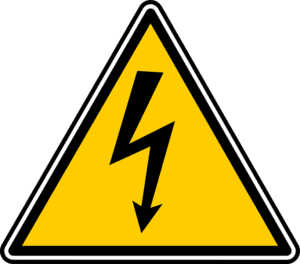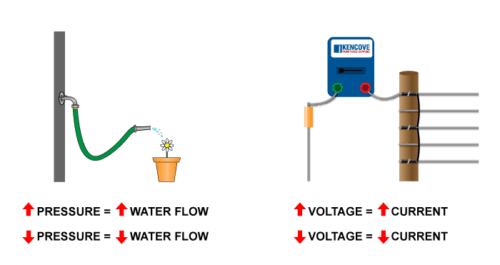
The other day I got a call from a farmer. For the sake of this blog, we’ll call him Bob. Bob wanted to know if his energizer was doing its job. He told me he was reading 7,000 volts on his fence and had an amp reading of 2. Bob wasn’t sure if that meant his fence was working well or not. I know enough about electric fences to know 7,000 volts is a great reading for cattle. In fact, anything between 5,000-9,000 volts is ideal, but your cattle species and temperament will determine the best voltage. I assured Bob that as long as his cattle were respecting the fence, he didn’t need to worry. I offered to dig further into amperage and voltage to give him a better answer.
Before we can determine if Bob has a good reading, we need to identify the differences between amps, voltage, ohms, watts, and all the other electrical lingo.

“Volts and Amps are engineering measurements used to define characteristics of an electricity supply. These measurements of a supply allow us to calculate the power a supply can deliver”
Voltage, current, and resistance are the basic units used when describing and understanding electrical flow.
Voltage: Volts Current: Amps Resistance: Ohms
So, let’s simplify this. The most common analogy, and the easiest way to describe the flow of energy, is by comparing energy to flowing water.
Volts = Water Pressure Amps = Water Volume
If you increase the pressure in your tank, you will, in turn, increase the water flow through your hose. This remains true with electricity. When increasing your voltage from your energizer, you increase the current, or amps, on your fence line (hose). Essentially, increasing your voltage decreases your resistance allowing for an easier (higher) flow. You can increase your energy two ways – through less resistance (more pressure) or a larger flow (larger hose).
You can increase the water flow out of a hose by adding more pressure, or by using a larger hose. In an electrical system, increasing either the current or the voltage will result in higher power.
The pressure remains in the hose, just like the power in your power lines remains when an energizer is unplugged or a light is turned off. Voltage is still present even if it is not in use.
“Current is like the rate of flow of water in the garden hose, say how many gallons per minute are moving in the hose. When the nozzle is turned off, there's still pressurized water in the hose, but there's no flow. When a light is turned off, the electrons are still in the wire, but they aren't flowing – there’s no current.”
To sum up this lesson in electrical engineering, volts are equal to the amount of charge, amps are the movement of the charge, ohms are the resistance of your line, and watts are your mathematical measurement of combining amps and volts.

Now back to our original question…are 7,000 volts and 2 amps good readings for an electric fence? Based on my findings, I would say no. You should actually have less amps!
In reality, a good solid fence should have high voltage, and low amps. Although our comparison of water and electricity shows more amps = more power, when it comes to electric fences, more amps = more power = a fault in your fence line.

Yes, that’s correct, a higher amp reading indicates that more power is needed to push your voltage down your fence line. Since you are needing more power, this is an indicator that power is being pushed somewhere other than your electric fence wire. Since Bob is getting an amp reading of 2, he is losing some energy in his fence. His reading of 7,000 volts may increase if he can figure out where the energy is leaking, whether it be through a cracked insulator, poor splice, or twisted t-post, he can increase his voltage by lowering his amps. In his case, at this moment, he doesn’t need to worry about finding his fault since he is reading 7,000 volts. However, in the future, if his voltage drops and his amps increase, he will need to identify the places where his voltage is leaking.
Our electrical fence lesson can simply be summed up as more volts and less amps make a good fence. Volts are the power running down your fence, amps are what pushes that power down the fence. If you have a high amp reading, you most likely have power flowing somewhere other than your fence.
Have a question? Give us a call at 1-800-KENCOVE. Our product specialists can guide you through planning, troubleshooting, and product selection.




